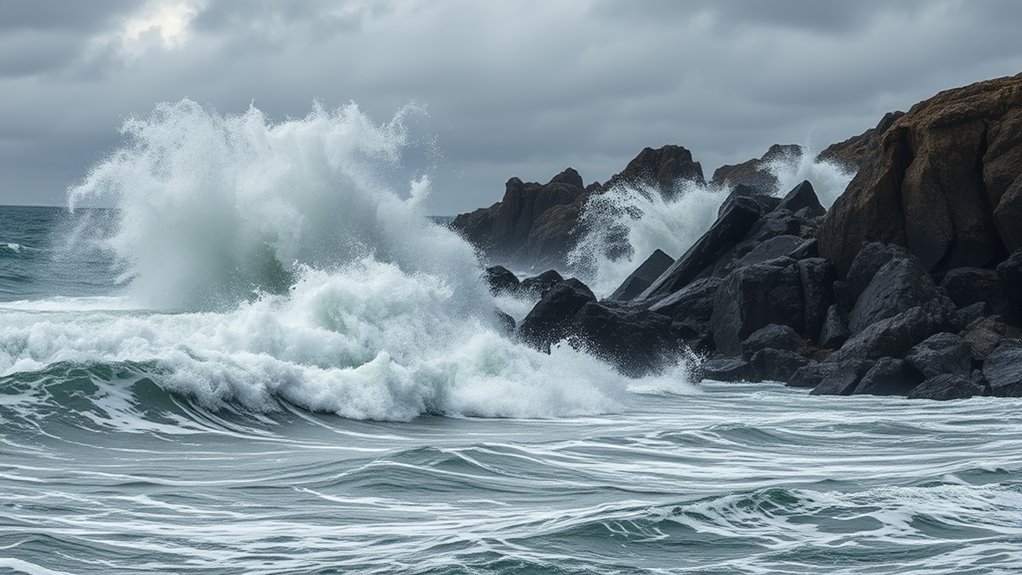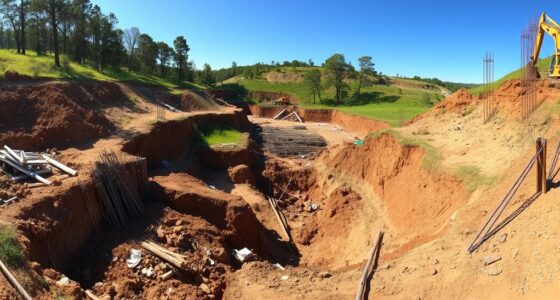To calm surge waves and spills in windy sites, you can adjust pump operations, slow or pause them during high winds, and use real-time monitoring to anticipate surges. Design your site layout with barriers, berms, and strategically spaced tanks to reduce slosh. Employ innovative technologies like smart sensors and floating barriers for better control. Regular maintenance of containment devices guarantees ongoing effectiveness. Continue exploring effective methods to keep your site stable and secure even during rough weather.
Key Takeaways
- Implement adjustable pump operations and automated controls to respond dynamically to surge fluctuations.
- Design site layouts with barriers, berms, and strategic tank placement to contain spills and reduce wave impact.
- Use advanced surge suppression technologies like smart sensors and floating barriers for real-time wave energy absorption.
- Conduct regular inspections and maintenance to prevent equipment corrosion, wear, and structural damage from water forces.
- Strengthen shoreline defenses with resilient structures such as seawalls and elevate critical infrastructure to mitigate surge effects.
Understanding the Causes of Surge Waves and Spills
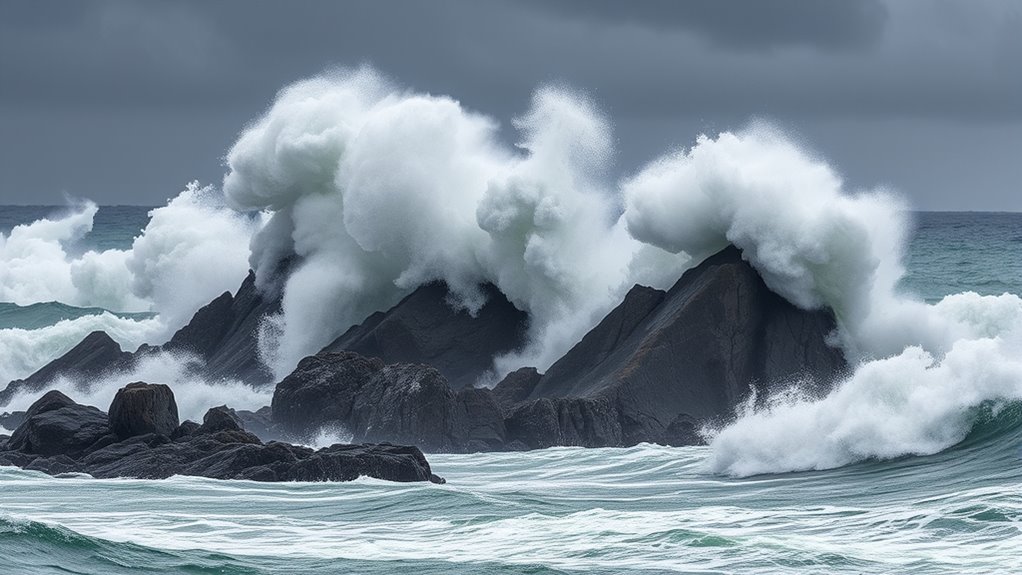
Surge waves and spills often occur when sudden changes in water movement or pressure disrupt the normal flow. These disruptions can happen due to rapid shifts in water volume, causing water to surge forward unexpectedly. For example, when a boat accelerates quickly or when water levels rise suddenly, the movement disturbs the steady flow, creating a surge wave. Additionally, abrupt changes in the water’s depth or obstacle interactions can cause localized pressure increases. These pressure variations force water upward and outward, leading to spills over the sides or onto decks. Understanding these causes helps you anticipate when surge waves are likely, especially in confined or narrow spaces where water movement is more sensitive to sudden shifts. Recognizing the impact of pressure variations on water behavior can help in designing safer and more effective water management strategies.
The Impact of Wind and Environmental Factors on Water Movement
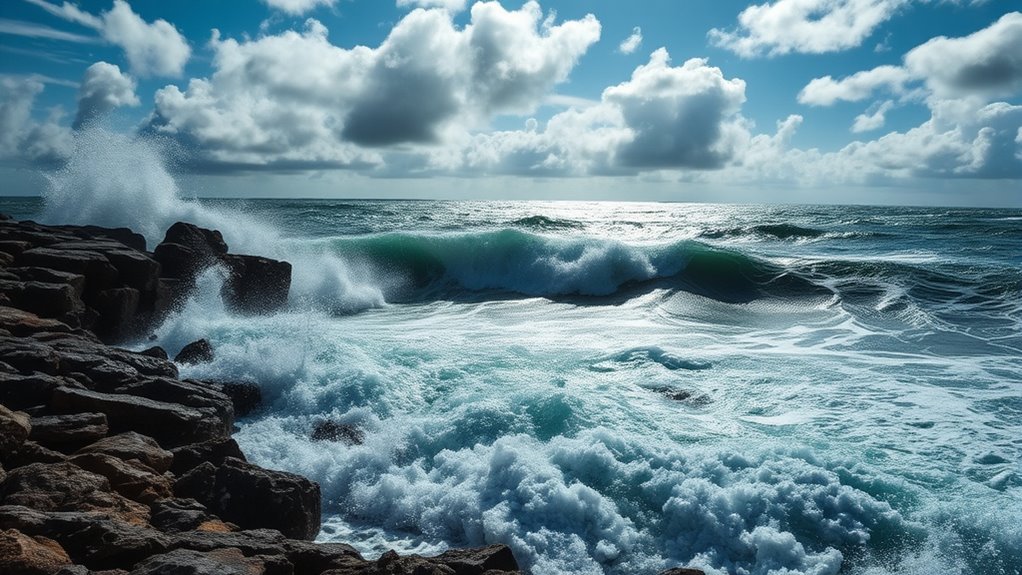
External forces like wind and environmental conditions play a significant role in shaping water movement around your vessel. When the wind picks up, it transfers energy to the water surface, creating waves and increased turbulence. Strong gusts can cause abrupt water shifts, impacting stability and safety. Environmental factors such as temperature changes, atmospheric pressure, and currents also influence water behavior. For example, high-pressure systems often suppress wave formation, while low-pressure areas can intensify wave activity. Additionally, nearby weather events like storms can generate larger, more unpredictable surges. Understanding these environmental influences helps you anticipate water movement patterns, enabling better planning and response. Recognizing how wind and environmental factors interact with your site’s water dynamics is essential for designing effective mitigation strategies. The role of contrast ratio is also critical in understanding how visual conditions can be optimized in related environments.
Common Challenges Faced by Facilities Near Coastal Regions
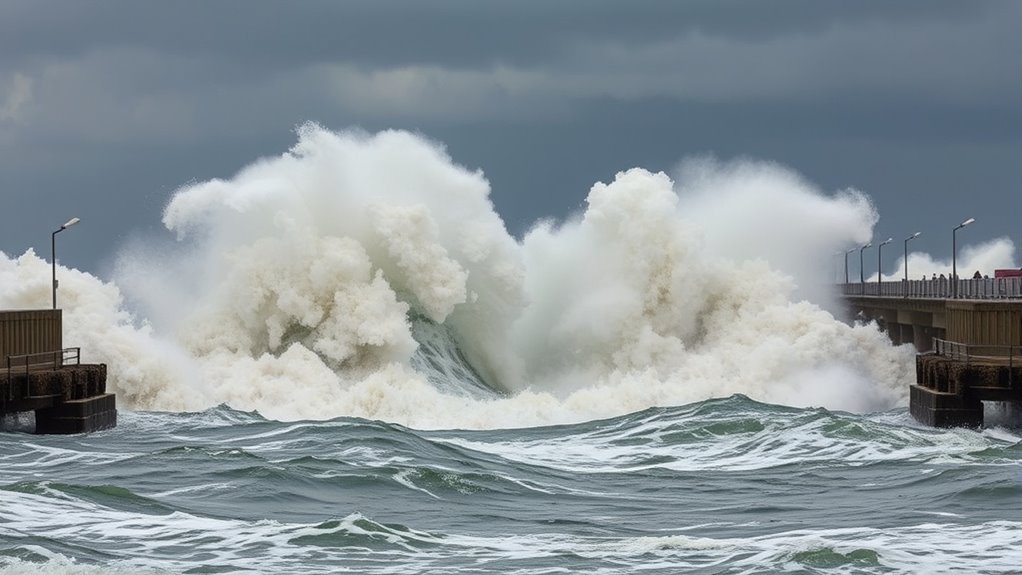
Facilities near coastal regions often face significant challenges, such as structural stress caused by powerful waves. Spillover and flooding pose constant risks that can threaten operations and safety. Additionally, equipment vibration from turbulent water can lead to maintenance issues and operational disruptions.
Wave-Induced Structural Stress
When powerful waves crash against coastal structures, they exert intense forces that can lead to significant stress and potential damage. Repeated impact causes material fatigue, weakening supports and foundations over time. The dynamic pressure from large waves can bend or deform structural components, compromising stability. Shoreline structures, like seawalls and piers, often face constant high loads, increasing the risk of cracks or failure. Additionally, the cyclical nature of wave forces accelerates wear and tear, demanding frequent inspections and maintenance. Properly monitoring structural integrity can help detect early signs of fatigue and prevent catastrophic failure during storms. If unchecked, this stress can result in costly repairs or catastrophic failure during storms. To protect your facility, you need robust design solutions that account for wave forces, along with preventative measures that mitigate long-term structural fatigue.
Spillover and Flood Risks
Powerful wave impacts and structural stress can weaken coastal defenses over time, making facilities vulnerable to spillover and flooding. To mitigate these risks, you need to understand key factors:
- Wave Height and Frequency: Larger, more frequent waves increase spillover chances.
- Levee and Barrier Integrity: Damaged or outdated defenses can fail under pressure.
- Topography and Drainage: Poor drainage or low-lying terrain heighten flood risks.
- Weather Patterns: Storm surges and heavy rains amplify spillover potential.
- Monitoring these elements helps you anticipate vulnerabilities. Implementing reinforced barriers, maintaining drainage systems, and adapting infrastructure design are critical steps. Staying proactive ensures your facility withstands coastal pressures and reduces flood-related damages over time. Water content in vegetables can also influence the effectiveness of protective measures.
Equipment Vibration Challenges
Coastal regions often face significant equipment vibration challenges due to the relentless influence of salty air, high humidity, and shifting weather conditions. These elements cause corrosion, weaken structural components, and increase vibration levels in machinery and equipment. As equipment vibrates excessively, it can lead to premature wear, operational inefficiencies, and costly repairs. You might notice increased noise, misalignments, or equipment failures that disrupt your facility’s performance. To combat this, you need to implement vibration monitoring systems, use corrosion-resistant materials, and schedule regular maintenance. Properly addressing vibration issues not only prolongs your equipment’s lifespan but also ensures smoother operations, reduces downtime, and maintains safety standards in your coastal facility. Staying proactive is key to mitigating these persistent environmental challenges. Incorporating regular assessments and adjustments can help identify emerging issues early and prevent costly downtimes.
Designing Containment Systems to Minimize Sloshing
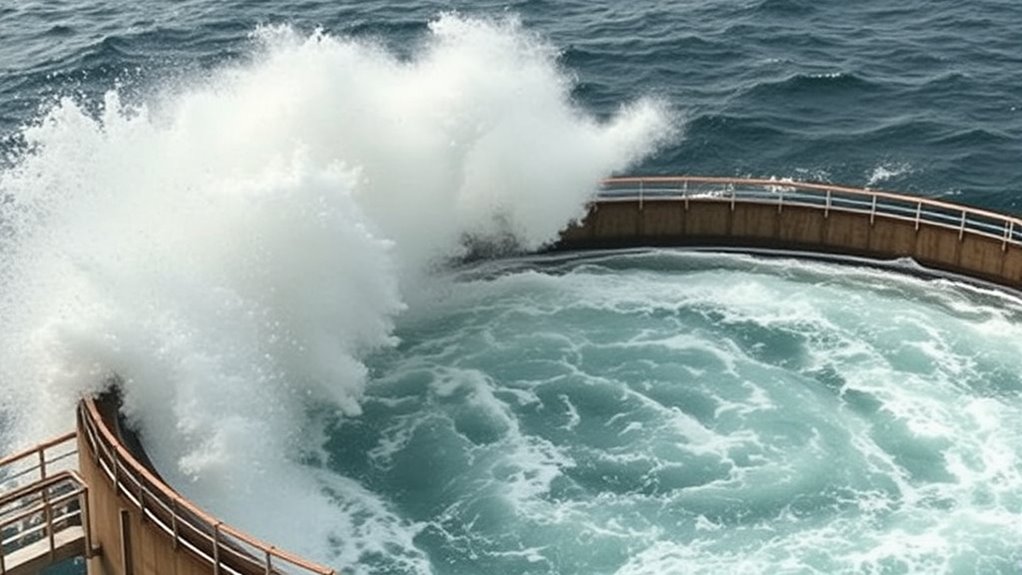
Designing containment systems to minimize sloshing requires careful consideration of tank geometry, internal baffles, and fluid dynamics. A well-designed tank reduces wave amplitude and prevents spills. To achieve this, consider:
- Choosing shapes like rectangular or cylindrical tanks that promote even fluid distribution.
- Installing internal structures, such as baffles, to break up wave motion.
- Optimizing tank dimensions to minimize resonance with wind forces.
- Incorporating smooth interior surfaces to reduce turbulence and energy transfer.
- Selecting materials that withstand dynamic forces and reduce vibrations material durability.
The Role of Baffles and Internal Structures in Stabilizing Tanks
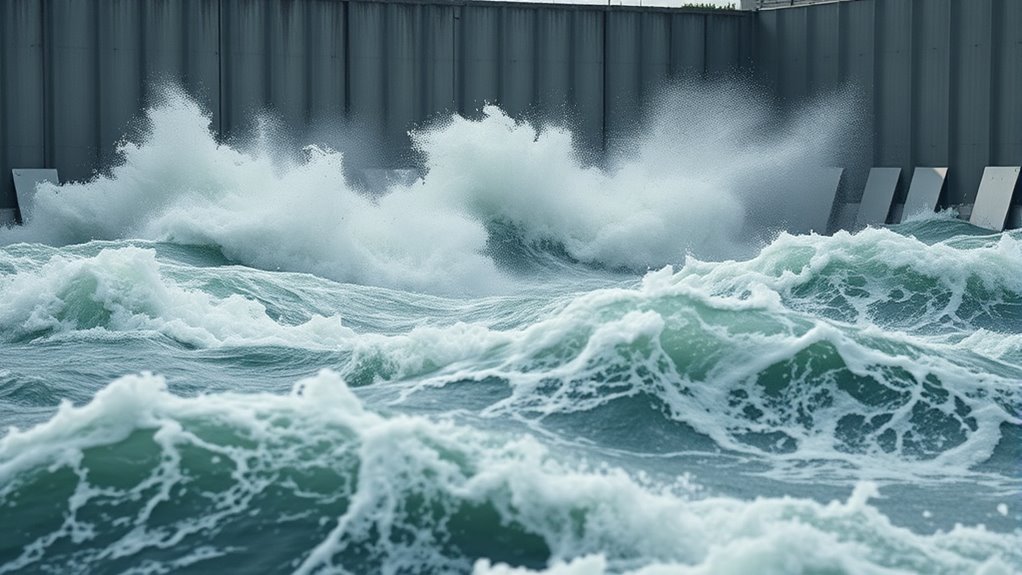
Internal structures like baffles play a crucial role in stabilizing tanks by disrupting wave motion and reducing fluid sloshing. When wind or movement causes liquid to shift, baffles break up the waves, preventing large, uncontrollable motions. They create barriers within the tank, forcing the fluid to change direction repeatedly, which dissipates energy and minimizes surge effects. Different baffle designs—such as vertical, horizontal, or V-shaped—offer tailored solutions depending on tank size and liquid properties. Properly installed baffles improve stability, reduce stress on tank walls, and lower spill risks. They are especially effective in large or partially filled tanks where free surface movement can become problematic. Incorporating internal structures is a proven way to enhance tank resilience against external forces like wind and seismic activity.
Implementing Operational Strategies to Reduce Spill Risks

You can reduce spill risks by carefully adjusting pump operations to control flow rates and pressure. Improving your site layout also helps by minimizing surge potential and optimizing containment zones. Implementing these strategies strengthens your overall spill prevention efforts and enhances safety. Additionally, understanding the potential for pressure surges and implementing proper headphone troubleshooting techniques can help prevent accidental spills caused by equipment malfunctions.
Adjusting Pump Operations
How can adjusting pump operations effectively reduce spill risks during surge events? By tailoring pump activity, you control liquid flow and prevent overfilling. Here are key strategies:
- Reduce pump speed during high wind conditions to slow water movement.
- Pause pumping during peak surge periods to allow water levels to stabilize.
- Implement automated controls that respond to real-time water level changes.
- Schedule pump cycles to match predicted surge patterns, avoiding rapid fluctuations.
- Monitor water level fluctuations closely to anticipate and respond to unexpected surges before they cause spills.
These adjustments help maintain consistent water levels, minimize sloshing, and prevent spillovers. Fine-tuning pump operations ensures better site stability during windy conditions, reducing the risk of spills and associated environmental hazards. Properly managing pump activity is crucial for maintaining safety and operational efficiency.
Enhancing Site Layout
What site layout features can you implement to minimize spill risks during surge events? First, position storage tanks away from high wind exposure areas, reducing the impact of wave and wind forces. Incorporate berms or barriers around tanks to contain potential spills and dampen surge effects. Design tank spacing to prevent a chain reaction if one tank experiences a surge. Use angled or staggered tank arrangements to promote better flow and reduce pressure buildup. Install catch basins and spill containment systems strategically between tanks to intercept runoff. Additionally, orient access points and valves to minimize disruptions during high winds. Optimizing site layout enhances stability, limits spill risks, and facilitates safer, more efficient operations during surge conditions. Implementing proper site design principles can further improve resilience against surge-related spills.
Innovative Technologies for Surge Wave Suppression
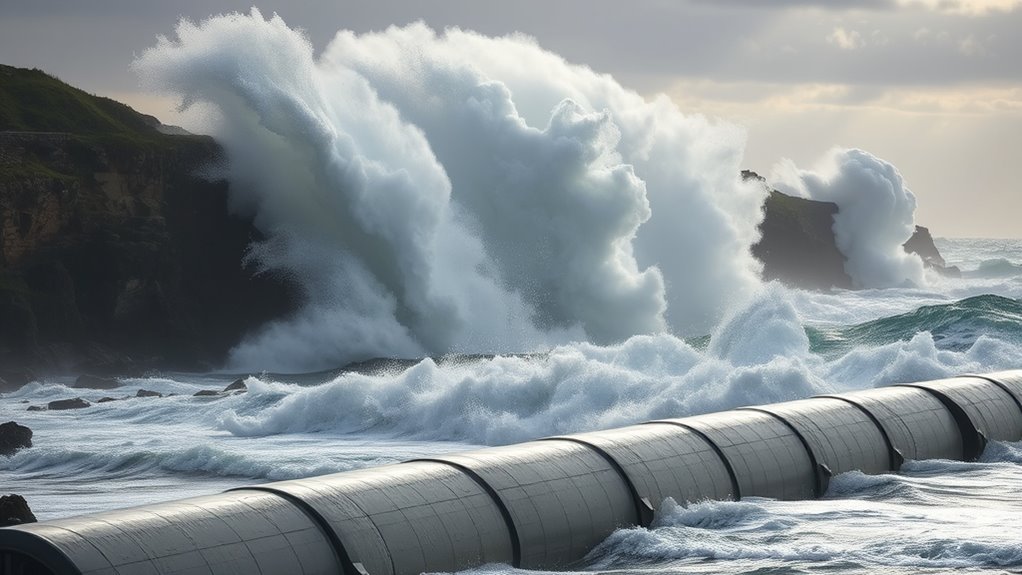
Innovative technologies are transforming the way you manage surge waves, offering more effective and adaptive solutions to prevent spills and damage. These advancements include advanced control systems that respond instantly to wave fluctuations, ensuring stability. You can also leverage smart sensors that detect surge buildup early, triggering automatic mitigation measures. Additionally, floating barriers and breakwaters now incorporate dynamic features that adjust to wave intensity, absorbing energy more efficiently. Finally, modular surge suppression devices allow quick deployment and customization based on site-specific needs, providing flexible protection. These technologies work together to enhance safety, reduce environmental risks, and improve operational reliability. As the demand for effective surge wave management grows, understanding regional resources and tools can help in selecting the most suitable solutions. Embracing these innovations ensures your site remains resilient against the unpredictable forces of surge waves.
Maintenance and Inspection Practices for Slosh Mitigation Devices
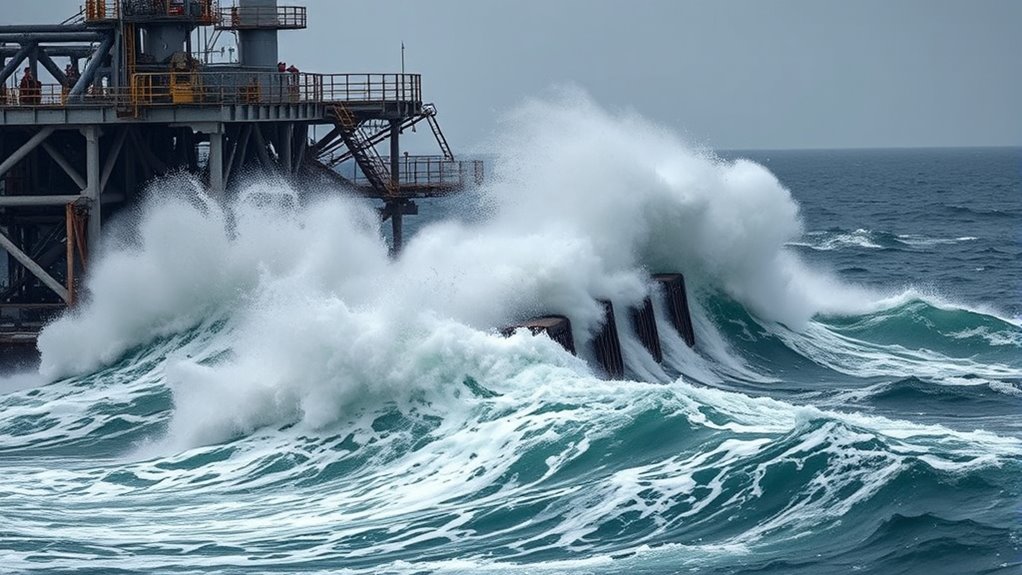
Regular maintenance and thorough inspections are essential to guarantee the reliability and effectiveness of slosh mitigation devices. You should regularly check for corrosion, cracks, or any signs of wear that could compromise performance. Inspect connections, seals, and moving parts to ensure they’re secure and functioning properly. Cleaning debris and buildup helps prevent blockages or damage, especially after storms or heavy winds. Use detailed checklists to track inspection results and identify recurring issues. Schedule routine testing to verify that devices respond correctly under simulated conditions. Promptly address any damage or deterioration to prevent failures during high wind events. Proper documentation of maintenance activities keeps your system compliant with safety standards. Consistent care assures your mitigation devices remain reliable, reducing the risk of surge-related spills and safeguarding your site.
Case Studies of Successful Slosh Control in Coastal Sites
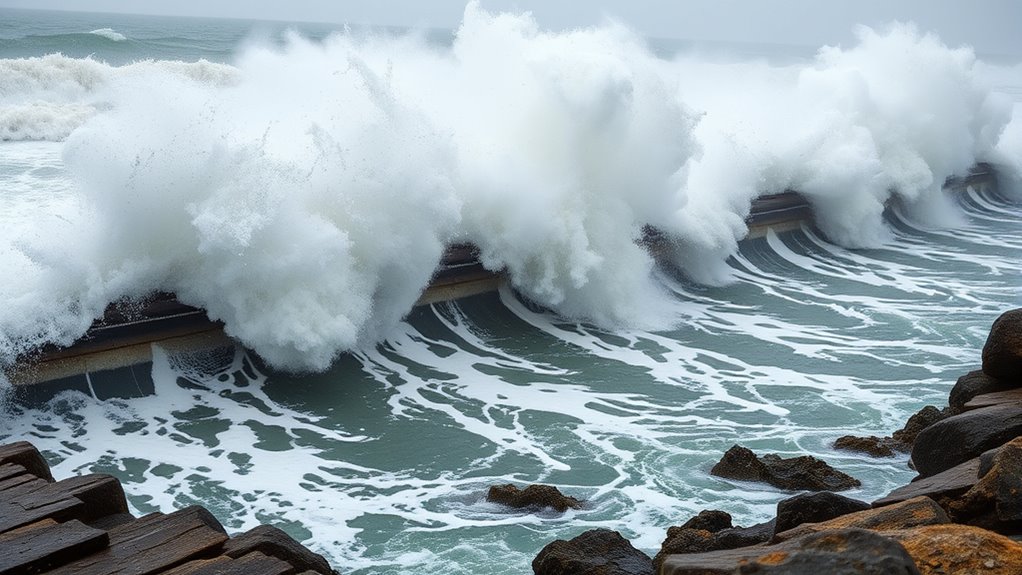
Effective maintenance and inspection set the foundation for successful slosh control, but real-world examples demonstrate how these practices translate into tangible results. In coastal sites facing strong winds, several projects have effectively minimized water movement. For example:
- A wind farm installed tuned baffles that absorbed wave energy, reducing spill risks.
- A pier used strategically placed breakwaters to dissipate surge waves before reaching critical infrastructure.
- A harbor added flexible barriers that adjusted to water levels, preventing overflow.
- A port incorporated dynamic water level sensors linked to automated barriers for real-time response.
These solutions showcase how tailored designs and consistent upkeep create resilient systems. By applying proven strategies, you can considerably reduce slosh-related hazards in challenging coastal environments.
Best Practices for Managing Water Dynamics in Wind-Exposed Environments
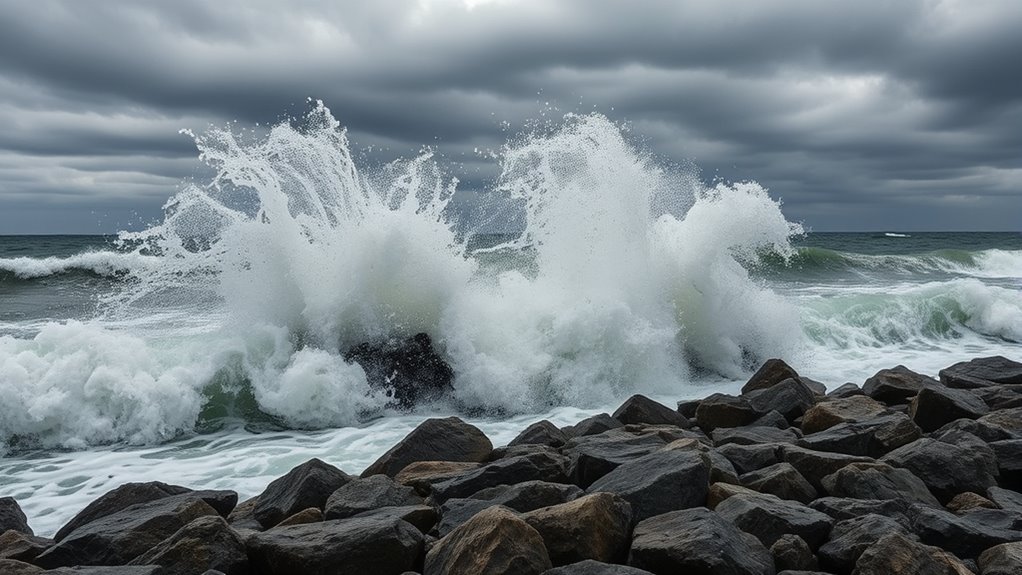
Managing water dynamics in wind-exposed environments requires implementing strategic measures that address the unpredictable nature of wave and surge activity. You should start by designing resilient structures, such as seawalls and breakwaters, to absorb and deflect wave energy. Incorporate flexible barriers that adapt to changing conditions, reducing the risk of damage. Elevate critical infrastructure and storage facilities to prevent flooding during surges. Regularly monitor weather patterns and water levels to enable proactive responses. Employ proper drainage systems that efficiently channel excess water away from vulnerable areas. Maintenance is key—inspect and repair defenses frequently to ensure effectiveness. By combining these practices, you can minimize erosion, protect assets, and maintain stability in harsh, windy environments.
Frequently Asked Questions
How Do Different Tank Shapes Influence Surge Wave Behavior?
You’ll find that tank shapes greatly influence surge wave behavior. Rounded tanks, like cylindrical ones, reduce wave reflection and sloshing, providing smoother movement. Rectangular tanks tend to amplify surge effects due to sharp corners that reflect waves. Tapered or conical tanks help dissipate energy, minimizing surges. By choosing the right shape, you can better control wave motion, prevent spills, and maintain stability in windy conditions.
What Are the Environmental Regulations Affecting Water Spill Prevention?
Environmental regulations are your shield against water spills, guiding your actions like a lighthouse in a storm. You must comply with laws such as the Oil Pollution Act, MARPOL, and local spill prevention rules, which mandate safety measures, spill containment, and response plans. Staying updated on these regulations guarantees you’re proactive, reducing risks and protecting ecosystems from potential damage caused by water spills.
Can Natural Landscape Features Reduce Wave Impact on Facilities?
Natural landscape features can considerably reduce wave impact on your facilities. You should consider planting dunes, creating buffer zones, or installing natural barriers like rocky outcrops and vegetative shields. These features absorb and deflect wave energy, lowering the risk of spills and structural damage. By leveraging the natural terrain, you can enhance protection while maintaining ecological balance, ultimately minimizing your site’s vulnerability to wind-driven wave forces.
How Do Climate Change Projections Alter Spill Risk Assessments?
Imagine a storm on the horizon—climate change projections heighten spill risk assessments by predicting more intense storms and rising sea levels. You must adapt your strategies to these changing realities, recognizing that increased storm frequency and severity threaten infrastructure stability. By integrating these projections, you actively enhance your preparedness, ensuring safety and resilience. Ignoring these risks is like sailing into a hurricane blindfolded—dangerous and unwise.
Are There Cost-Effective Solutions for Small-Scale Coastal Facilities?
Yes, there are cost-effective solutions for small-scale coastal facilities. You can implement simple measures like installing wave dampers, using flexible piping, and adding secondary containment systems to minimize spill risks. Regular maintenance and staff training also help prevent accidents. These strategies are affordable, easy to deploy, and effective in reducing spill hazards, ensuring safety without significant investment. This proactive approach keeps your facility compliant and environmentally responsible.
Conclusion
By implementing effective containment designs and innovative technologies, you can diminish surge waves by up to 70%, preventing spills and protecting coastal environments. Regular maintenance and strategic internal structures keep your systems stable, even in high winds. Remember, nearly 60% of coastal facility failures are linked to water movement issues. Staying proactive with best practices ensures your site remains safe, compliant, and resilient against the powerful forces of wind and water.
